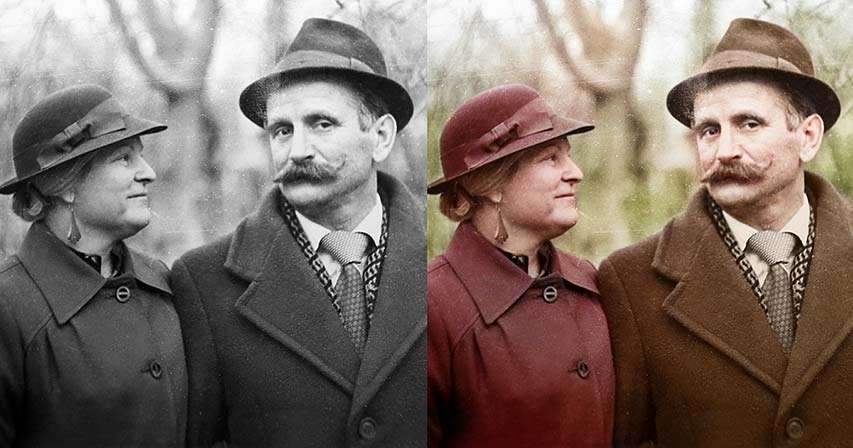To change black and white JPEG to color, here’s a quick guide:
- Click Here to visit ImgCreator.ai
- Uploading Your Black and White Image
- Adjusting the Settings for Best Results
- Exporting Your Colorized Image
It’s a sunny afternoon. You’re sifting through old family albums and suddenly, amidst those color photos, you come across a black and white JPEG of your ancestors, perhaps at an iconic location or during a historic event. You’re entranced by its charm, but a thought pops into your mind, “What if this picture was in color?”.

Introduction to Colorization The Magic of Bringing Photos to Life
Colorizing photos is more than just adding hues and saturation to an image. It’s about breathing life into history, making the past tangible and relatable. Every stroke of color we add is like a stroke of paint on a canvas, helping a memory come alive.
Understanding the JPEG Format
JPEGs, being one of the most popular formats out there, have certain intricacies that are vital to understanding colorization. JPEG: More Than Just a File Extension Developed by the Joint Photographic Experts Group (thus the name), the JPEG format became a staple because of its ability to compress images without significant quality loss. It’s not just a mere format; it’s a bridge between storage efficiency and visual delight. The Importance of Color Depth in JPEG Every image has a color depth, which refers to the number of bits used to represent the color of a single pixel. For JPEGs, this is usually 24 bits, allowing for millions of color variations. This rich depth ensures that when you convert from black and white, the image can encompass a vast spectrum of colors without looking flat or artificial.
The Tool: Imgcreator
With numerous software options available, why go with Imgcreator?
Key Features of Imgcreator
Beyond its sleek interface, Imgcreator integrates sophisticated machine learning algorithms. This allows it to predict and implement colors that feel organic to the photo.
Why Choose Imgcreator for Colorization?
While there are many image editing tools, Imgcreator is specifically calibrated for colorization. Its AI-enhanced features analyze the grayscale values and contextual objects in a photo, predicting likely colorations.
Step-by-Step Guide to Using Imgcreator
Imgcreator’s magic can be wielded by anyone, no expert knowledge is required.
- Uploading Your Black and White Image Once on Imgcreator’s homepage, find the prominently displayed upload option. Some tips: Ensure your image is clear and high-resolution for best results.
- Adjusting the Settings for Best Results After uploading, you’ll be presented with a dashboard of settings. Each adjustment can have a profound effect on the outcome. For instance, tweaking the contrast can give you brighter colors, while playing with the brightness can help in achieving that perfect vintage look.
- Exporting Your Colorized Image With all adjustments made, hit ‘colorize’. In moments, your image will be transformed. Review it, make any last-minute tweaks, and then proceed to download. Remember, the first attempt might not be perfect. It’s art, after all. Feel free to experiment!

Tips for Achieving Realistic Results Understanding Original Context
Delve into the history of the photograph. Knowing it was a summer day can guide you to add warmer tones, while a winter setting might be cooler and muted. Play with Color Settings The first result is just a draft. Colors can be overwhelming, underwhelming, or just right. It’s your canvas; paint it as you see fit!
The Art and Science Behind Colorization Historical Context is Key
When researchers colorize historical photos, they dive into records, analyzing the fashion of the time, the colors popular in that era, and even the time of day an event took place. The same principles can guide your efforts.
Imgcreator’s Technology Decoded
The tool uses a combination of neural networks and vast image databases. By comparing your black and white image with thousands of colored images, it predicts the most likely colors.
Other Tools vs. Imgcreator
While tools like Photoshop offer manual colorization, Imgcreator speeds up the process using AI. It’s the difference between hand-painting a mural and printing a high-res image – both have their merits, but one is undeniably faster.
Conclusion
A journey that began with a simple question – “How do I change a black and white JPEG to color?” – has led us through the winding paths of history, technology, and art. With Imgcreator, the past isn’t just black and white; it’s a vibrant spectrum, waiting to be rediscovered.
FAQs
- Does colorizing an image alter its historical accuracy? While colorization adds vibrancy, it’s based on modern interpretations and might not represent the exact historical colors.
- Is there a loss in image quality during colorization? Imgcreator ensures minimal quality loss, but always check the output against the original.
- How do AI-based tools predict colors? They compare grayscale values in your image with vast databases of colored photos, predicting the most likely colors based on patterns.
- Why does the same image colorized by different people/tools look different? Colorization is as much an art as it is a science. Different tools and artists have their interpretations.
- Can I revert my image back to black and white after colorization? Yes, most image editing tools will allow you to revert to a grayscale version.
Read More
The Evolution of Black and White Photography
The charm of black and white photos isn’t just by chance. The art of photography began without the vibrant hues we see today. This wasn’t a stylistic choice but a limitation of technology. Early photographers had to navigate numerous challenges, from long exposure times to a lack of stable and long-lasting colors in their materials.
How Colors Evoke Emotions
Colors are not just visual elements; they resonate with our emotions. A bright blue sky can evoke feelings of joy and hope, while the deep reds of a setting sun can stir emotions of reflection and melancholy. When we add color to a black-and-white image, we’re not merely adding aesthetics but emotions.
Considerations Before Colorizing
One must respect the sanctity of the original photo. Before diving headfirst into colorization, ask yourself:
- What’s the goal of this endeavor?
- Will color enhance or take away from the original sentiment?
- Are you looking to restore it to how it might’ve looked originally, or are you reinventing the image?
Deep Dive: The Technology Behind Imgcreator
Imgcreator isn’t a simple photo-editing tool. It’s the culmination of years of research.
- Neural Networks: At the heart of Imgcreator’s capability is its use of deep neural networks. These networks are designed to mimic the human brain, allowing the software to “learn” from countless examples and improve over time.
- Continuous Learning: The more images Imgcreator processes, the more refined its algorithms become. As users worldwide upload and adjust their photos, the tool learns from these iterations, continuously improving its predictions and accuracy.
- Safety and Privacy: In an era where data breaches are commonplace, Imgcreator prioritizes user privacy. Uploaded images are processed and then removed, ensuring users’ memories remain their own.
Advanced Techniques for Professional Results
While Imgcreator does a bulk of the heavy lifting, professionals often use it in tandem with other tools.
- Layering with Transparency: Professionals often overlay the colorized image on the original, adjusting the transparency to achieve the desired effect.
- Selective Color Boosting: Sometimes, certain areas of the photo might require more vivid colors. Tools like Photoshop can be used in conjunction to enhance specific regions.
- Incorporating Textures: Old photos often have grain. To maintain authenticity, professionals might introduce similar textures post-colorization.
Colorization in Popular Culture
The act of colorizing isn’t just for personal photos. In recent years, filmmakers and documentarians have been restoring old footage, and transforming it into color. This has introduced historical events to younger generations in a more relatable format.
Ethical Implications of Colorization
Adding color to an image introduces a subjective element. It’s essential to be aware of the ethical implications:
- Misrepresentation: If done incorrectly or with the wrong intent, colorization can misrepresent history.
- Cultural Sensitivity: Colors have different cultural significances. It’s essential to be aware of these nuances to avoid unintentional insensitivities.
Trends in Colorization
With technology’s evolution, colorization has seen a resurgence. Artists and historians are collaborating, creating exhibitions that juxtapose the original black-and-white images with their colorized counterparts. The intent isn’t to replace the original but to provide an alternate perspective.
User Testimonials on Imgcreator
Jane, a historian, says, “Imgcreator has transformed the way I present my lectures. My students are more engaged when they see historical figures in color.” While Mark, an artist, mentions, “It’s a unique blend of past and present. Taking a timeless moment and adding my interpretation through color.”
The Limitations of Colorization
While technology has advanced leaps and bounds, there are still limitations. Colorization can sometimes fail to capture the minute subtleties of real life, making scenes appear slightly artificial or out of place. However, with continuous improvements, this gap is steadily narrowing.
Conclusion
The journey of colorization is fascinating. From its humble beginnings as a manual, labor-intensive process to sophisticated AI-driven tools like Imgcreator, the transformation of black and white photos into vibrant, colorful images has never been more accessible. But, as with all tools, it’s not just about the technology but the intent, emotion, and respect for the original material that drives a successful transformation. Whether you’re a professional photographer or someone looking to breathe life into old family photos, the world of colorization holds endless possibilities. Dive in, and let your imagination paint the canvas!
